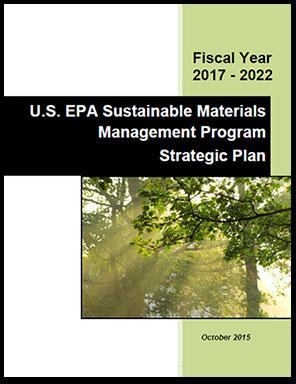Sustainable Materials Management Basics
On this page:
- What is Sustainable Materials Management?
- A Life Cycle Perspective
- Sustainable Materials Management Program Strategic Plan
What is Sustainable Materials Management?
Sustainable materials management (SMM) is a systemic approach to using and reusing materials more productively over their entire life cycles. It represents a change in how our society thinks about the use of natural resources and environmental protection. By examining how materials are used throughout their life cycle, an SMM approach seeks to:
- Use materials in the most productive way with an emphasis on using less.
- Reduce toxic chemicals and environmental impacts throughout the material life cycle.
- Assure we have sufficient resources to meet today’s needs and those of the future.
How our society uses materials is fundamental to our economic and environmental future. Global competition for finite resources will intensify as world population and economies grow. More productive and less impactful use of materials helps our society remain economically competitive, contributes to our prosperity and protects the environment in a resource-constrained future.
U.S. and global consumption of materials increased rapidly during the last century. According to the Annex to the G7 Leaders’ June 8, 2015 Declaration, global raw material use rose during the 20th century at about twice the rate of population growth. For every 1 percent increase in gross domestic product, raw material use has risen by 0.4 percent. This increasing consumption has come at a cost to the environment, including habitat destruction, biodiversity loss, overly stressed fisheries and desertification. Materials management is also associated with an estimated 42 percent of total U.S. greenhouse gas emissions. Failure to find more productive and sustainable ways to extract, use and manage materials, and change the relationship between material consumption and growth, has grave implications for our economy and society.
Sustainable Material Management’s Life-cycle Perspective
 Materials have environmental impacts throughout their lifecycles. The major stages in a material’s lifecycle are raw material acquisition, materials manufacture, production, use/reuse/maintenance, and waste management.By looking at a product's entire life cycle—from materials extraction to end-of-life management—we can find new opportunities to reduce environmental impacts, conserve resources, and reduce costs. For example, a product may be re-designed so it is manufactured using different, fewer, less toxic and more durable materials. It is designed so that at the end of its useful life it can be readily disassembled. The product’s manufacturer maintains a relationship with its customers to ensure best use of the product, its maintenance and return at end-of-life. This helps the manufacturer identify changing needs of their customers, create customer loyalty, and reduce material supply risk. Further, the manufacturer has a similar relationship with its suppliers, which helps the manufacturer respond more quickly to changing demands, including reducing environmental impacts along the supply chain.
Materials have environmental impacts throughout their lifecycles. The major stages in a material’s lifecycle are raw material acquisition, materials manufacture, production, use/reuse/maintenance, and waste management.By looking at a product's entire life cycle—from materials extraction to end-of-life management—we can find new opportunities to reduce environmental impacts, conserve resources, and reduce costs. For example, a product may be re-designed so it is manufactured using different, fewer, less toxic and more durable materials. It is designed so that at the end of its useful life it can be readily disassembled. The product’s manufacturer maintains a relationship with its customers to ensure best use of the product, its maintenance and return at end-of-life. This helps the manufacturer identify changing needs of their customers, create customer loyalty, and reduce material supply risk. Further, the manufacturer has a similar relationship with its suppliers, which helps the manufacturer respond more quickly to changing demands, including reducing environmental impacts along the supply chain.
Learn more about the potential benefits of a lifecycle approach to materials management in Sustainable Materials Management: The Road Ahead
Life Cycle Assessment (LCA) is a technique to make more informed decisions through a better understanding of the human health and environmental impacts of products, processes, and activities. This can include an evaluation of the air, water, land, and energy consequences of a product or process, and possible alternatives. To learn more, see the Sustainable Materials Management Coalition’s Guidance on Life-Cycle Thinking and Its Role in Environmental Decision Making Exit
Sustainable Materials Management Program Strategic Plan for Fiscal Years 2017 - 2022
 EPA’s Sustainable Materials Management Program (SMM) Strategic Plan represents the collective thinking of EPA staff and management across the country, and includes stakeholder input from states, industry and nongovernmental organizations. The following three strategic priority areas chosen as the focus for EPA’s future SMM efforts present significant opportunities to achieve environmental, economic and social results:
EPA’s Sustainable Materials Management Program (SMM) Strategic Plan represents the collective thinking of EPA staff and management across the country, and includes stakeholder input from states, industry and nongovernmental organizations. The following three strategic priority areas chosen as the focus for EPA’s future SMM efforts present significant opportunities to achieve environmental, economic and social results:
- The Built Environment -conserve materials and develop community resiliency to climate change through improvements to construction, maintenance, and end-of-life management of our nation’s roads, buildings, and infrastructure
- Sustainable Food Management -focus on reducing food loss and waste and
- Sustainable Packaging -increase the quantity and quality of materials recovered from municipal solid waste and develop critically important collection and processing infrastructure.
In addition to these strategic priorities, EPA will continue work in other SMM emphasis areas, including sustainable electronics management, measurement, life cycle assessment and international SMM efforts.
